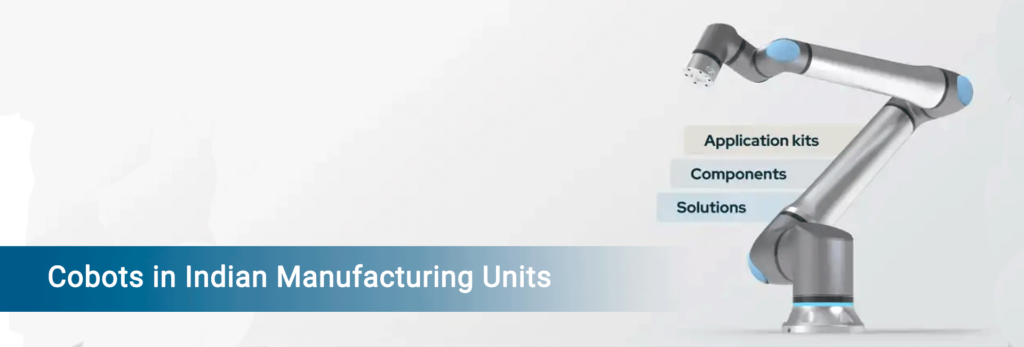Automate your shop floor and increase productivity by 85%
During these tough times, all manufacturing companies are going through the common problem everywhere mainly with Labor shortages, space issues, low productivity against unpredictable market demands, high resource/ raw material wastage, quality issues like less accuracy, repetitive human errors, huge investment in safety, etc. Are you facing these issues too? If yes, read on.
We have been talking to several of our privileged clients lately and probed on what they have been doing to tackle these problems really?
And we found out that among many other things, Indian manufacturers have learned to beat the uncertainties with many modern technological advancements in the current assembly line set-up, where they share the workspace between humans and robots in a safe way (and with major benefits apart from the cost.)
Yes, we are talking about man and machine collaboration. Not the heavy industrial robots, but the easy and compact option.
We are talking about lightweight and easy-to-use Collaborative Robots. Unlike traditional industrial robots – cobots or collaborative robots are safe, flexible, quick to deploy and help eliminate the organic risks to workers. Their collaborative nature makes them simple and affordable to enable partial automation, even in areas previously considered difficult to automate.
Manufacturer’s dream come true
Known as Cobots, cobots in manufacturing are automated solutions designed to complete monotonous, repetitive, boring, and physically demanding tasks at the manufacturing unit. They can be integrated with existing machinery and other robots through PLCs and sophisticated programming software. Typically, Cobots work alongside the human workforce, making their jobs easier that enhancing human-robot collaboration resulting in reduced human errors, increased output, and improved efficiency across the board.
They allow companies to use their skilled manpower force (who have now become part of the ‘scarce resources’) for more valuable and productive work.
“COBOTS Have Proven to Be 85% More Productive Than A Human or Robot Alone”
Unleash The Power of Technology!
Given the current changing economic landscape, manufacturers need a dynamic solution that’s future-proof and has competitive advantages too. And that is the sole reason why Cobots are gaining popularity in all Indian industries. In the times of global automation, the way robots work together with humans has become more important than ever.
Let us understand in brief some of the benefits of Cobots in Indian Manufacturing set-ups that are cost-saving:
- Eliminate labor dependency
- Increased productivity & consistency with improved cycle time
- Improved quality with high accuracy & repeatability
- Improved flexibility
- Operates on a single Phase Power supply.
- Does not requires safety fences/ cages, consuming less project space.
- Small footprint
- Zero maintenance
- Less rejection rate
Role of Cobots:
The role of a cobot in manufacturing becomes most crucial in situations where a human is near the robot. This involves situations where human guides the robots, monitor them or even in cases where he learns from the robots.
Among the main characteristics of cobots will be the quality-of-service needs, which may vary with time and context. Let us look at an example of cobots in a manufacturing facility along with the safety zones associated with each collaborative robot. The safety zones may vary according to the proximity of human workers, the proximity of obstacles and the speed of the cobot.
To facilitate the control system to react and to take decisions on time, the communication needs to be reliable and highly efficient. A cobot near human workers needs more attention than cobots in a manufacturing facility without humans. Thus, a high amount of signalling, high bandwidth, fast decision-making abilities and low latency is a must for cobots deployed in more safety-critical environments.
Why Patvin for Cobot Solutions?
Patvin’s customized Collaborative robotic Solutions have emerged as a powerful resource for Indian manufacturers facing critical business pain points. Designed for precision and consistency, our Cobots enable our customers to create a flawless final product. Top it up with the expertise of 33 years of providing engineering automation solutions and a skilled team available 24×7 to tend to the queries, if any.
FAQs
Robots: Robots are machines designed to work autonomously or semi-autonomously. They perform tasks without human intervention often replacing human labor in tasks that are repetitive or dangerous. They usually operate in isolation, away from humans, for safety reasons.
Cobots: Cobots, or collaborative robots, work alongside humans. Cobots are flexible and can handle tasks that need human collaboration. They are safe to use around people and are easy to program. TV cobots, for example, are used in broadcasting for camera operations.
Here are the different types of cobots (collaborative robots) that Patvin Engineering offers:
Power and Force Limiting Cobots
Safety Rated and Monitored Stop Cobots
Speed and Separation Cobots
Hand Guiding Cobots
TV Cobots
- Inspection Cobots
- Welding Cobots
Here are the uses of cobots (collaborative robots) that Patvin Engineering specializes in,
Assembly Tasks
Machine Tending
Packaging and Palletizing
Material Handling
Quality Control
TV Cobots
- Medical Applications
- Welding and Painting
- Electronics Manufacturing
- Research and Development
Cobots, or collaborative robots, operate alongside humans. They perform tasks using advanced sensors and programming.
- Sensors: Cobots have sensors that detect human presence.
- Programming: Cobots are easy to program with simple software.
- Adaptability: Cobots adapt to various tasks and environments.
- Precision: Cobots perform tasks with high accuracy.
- Integration with Equipment: Cobots can easily connect with other machines.
Disadvantages of Cobots:
- Payload Limitations
- Speed Constraints
- Not Fully Autonomous
- Precision Challenges
- Specific Applications
- Limited Strength
- Slower Speed
- High Initial Investment
- Integration
Advantages of Cobots:
- Improved Safety
- Increased Efficiency
- Flexibility
- Cost-Effectiveness
- User-Friendly Operation
- Safety
- Flexibility
- Ease of Use
- Cost-Effective
- Precision
Recommended read: All about Cobots
The future scope of cobots is promising and expansive. Cobots in India are set to revolutionize various industries by enhancing productivity and safety. Here are some key aspects of their future:
- Increased Adoption
- Technological Advancements
- Expansion of Applications
- Integration with Other Technologies
- Focus on Safety and Collaboration
- Market Growth
- Specialized Models
Cobot stands for collaborative robot.
Cobots in manufacturing perform tasks like assembly, quality control, and material handling. They work alongside humans, enhancing productivity and safety. Manufacturers use them for tasks like assembly, packaging, and quality control. They are adaptable and can switch between different tasks quickly. Cobots can handle repetitive tasks allowing human workers to focus on complex jobs.
Cobots use advanced technologies like artificial intelligence and machine learning. They have precise motion control systems featuring user-friendly programming interfaces allowing them to adapt to different tasks over time. and user-friendly programming interfaces. These technologies enable cobots to perform complex tasks with high accuracy.
Cobots use various sensors to ensure safe and efficient operation. These include:
Proximity Sensors: Detect nearby objects to prevent collisions
Force/Torque Sensors: Measure the force and torque applied by the cobot.
Vision Systems: Use cameras to identify and locate objects.
Touch Sensors: Detect contact with objects or humans for safe interaction.
Patvin being the leading cobot manufacturer in India incorporates these sensors to enhance the performance and safety of their cobots
Cobots, or industrial collaborative robots, are designed to work alongside humans enhancing the productivity and safety in manufacturing. They are more flexible, easier to program, and can be used for a wider range of tasks than traditional robots.
Patvin Engineering is a leading supplier providing top-quality cobots. We offer a wide range of Cobots, including the Universal Robots, Svaya Robotics, and Systemantics at competitive price range. You can get in touch with us for more information!
Unlike traditional industrial robots, cobots are equipped with sensors and safety features that allow them to interact with humans safely. Cobots are collaborative robots that work alongside humans. Indian manufacturers are adopting cobots to automate repetitive tasks while ensuring safety and flexibility in the workplace.
Cobots enhance productivity by working alongside human operators to complete tasks faster and with higher accuracy. They reduce human error and increase output rates, making them a valuable addition to manufacturing processes across various sectors in India.
TV Cobots, or task-specific collaborative robots, are designed for particular applications like assembly, packaging, and quality inspection. They play a crucial role in automating tasks in industries like electronics and precision manufacturing in India. They help streamline operations by taking over monotonous tasks, allowing human workers to focus on more complex activities.
Cobots are versatile and can be used in multiple industries such as:
- Automotive
- Electronics
- Food and Beverage
- Healthcare
- Pharmaceuticals
- Consumer Goods
- Renewable energy
- Chemical Industries
Cobots are being used in a variety of applications in Indian manufacturing, including Assembly, Packaging, Machine tending, and Quality inspection.



